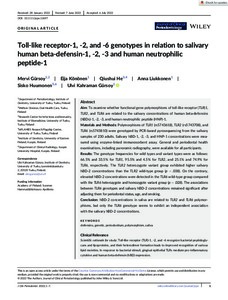Toll-like receptor-1, -2, and -6 genotypes in relation to salivary human beta-defensin-1, -2, -3 and human neutrophilic peptide-1
Huumonen Sisko; Liukkonen Anna; Gürsoy Ulvi Kahraman; Gürsoy Mervi; He Qiushui; Könönen Eija
https://urn.fi/URN:NBN:fi-fe2022091258534
Tiivistelmä
Aim: To examine whether functional gene polymorphisms of toll-like receptor (TLR)1, TLR2, and TLR6 are related to the salivary concentrations of human beta-defensins (hBDs)-1, -2, -3, and human neutrophilic peptide (HNP)-1.
Materials and methods: Polymorphisms of TLR1 (rs5743618), TLR2 (rs5743708), and TLR6 (rs5743810) were genotyped by PCR-based pyrosequencing from the salivary samples of 230 adults. Salivary hBD-1, -2, -3, and HNP-1 concentrations were measured using enzyme-linked immunosorbent assay. General and periodontal health examinations, including panoramic radiography, were available for all participants.
Results: The genotype frequencies for wild types and variant types were as follows: 66.5% and 33.5% for TLR1, 95.5% and 4.5% for TLR2, and 25.1% and 74.9% for TLR6, respectively. The TLR2 heterozygote variant group exhibited higher salivary hBD-2 concentrations than the TLR2 wild-type group (p = .038). On the contrary, elevated hBD-2 concentrations were detected in the TLR6 wild-type group compared with the TLR6 heterozygote and homozygote variant group (p = .028). The associations between TLR6 genotypes and salivary hBD-2 concentrations remained significant after adjusting them for periodontal status, age, and smoking.
Conclusion: hBD-2 concentrations in saliva are related to TLR2 and TLR6 polymorphisms, but only the TLR6 genotype seems to exhibit an independent association with the salivary hBD-2 concentrations.
Kokoelmat
- Rinnakkaistallenteet [19249]
